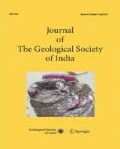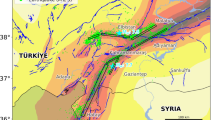Abstract
We present the estimated source parameters from SH-wave spectral modeling of selected 463 aftershocks (2002–06) of the 26 January 2001 Bhuj earthquake, the well-recorded largest continental intraplate earthquake. The estimated seismic moment (Mo), corner frequency (fc), source radius (r) and stress drop (Δσ) for aftershocks of moment magnitude 1.7 to 5.6 range from 3.55×1011 to 2.84×1017 N-m, 1.3 to 11.83 Hz, 107 to 1515 m and 0.13 to 26.7 MPa, respectively, while the errors in fc and Δσ are found to be 1.1 Hz and 1.1 MPa, respectively. We also notice that the near surface attenuation factor (k) values vary from 0.02 to 0.03. Our estimates reveal that the stress drop values show more scatter (Mo0.5 to 1 is proportional to Δσ) toward the larger Mo values (≥1014.5 N-m), while they show a more systematic nature (Mo3 is proportional to Δσ) for smaller Mo values (<1014.5 N-m), which can be explained as a consequence of a nearly constant rupture radius for smaller aftershocks in the region. The large stress drops (= 10 MPa) associated with events on the north Wagad fault (at 15–30 km depth) and Gedi fault (at 3–15 km depth) can be attributed to the large stress developed at hypocentral depths as a result of high fluid pressure and the presence of mafic intrusive bodies beneath these two fault zones.
Similar content being viewed by others
References
Abercrombie, R. and Leary, P. (1993) Source parameters of small earthquakes recorded at 2.5 km depth, Cajon Pass, Southern California: Implications for earthquake scaling. Geophys. Res. Lett., v.20, pp.1511–1514.
Abercrombie, R.E. (1995) Earthquake source scaling relationships from -1 to 5 ML using seismograms recorded at 2–5 km depth. Jour. Geophys. Res., v.100, pp.24015–24036.
Aki, K., 1967. Scaling law of seismic spectrum, J. Geophys. Res., v.72, pp.1217–1231.
Aki, K. (1972) Earthquake mechanism, Tectonophysics v.13, pp.423–446.
Anderson, J.G. and Hough, S.E., 1984. A model for the shape of the Fourier amplitude spectrum of acceleration at high frequencies, Bull. Seism. Soc. Amer., v.74, pp.1969–1994.
Anderson, J.G. (1986) Implication of attenuation for studies of the earthquake source. In: M. Ewing (Ed.), Earthquake Source Mechanics. Amer. Geophys. Union, Geophysical Monograph 37, v.6, pp.311–317.
Antolik, M. and Dreger, D.S. (2003) Rupture process of the 26 January 2001 Mw 7.6 Bhuj, India, earthquake from teleseismic broadband data. Bull. Seism. Soc. Amer., v.93, pp.1235–1248.
Archuleta, R.J., Cranswick, E., Muellar, C. and Spudich, P. (1982) Source parameters of the 1980 Mammoth Lakes, California, Earthquake sequence. Jour. Geophys. Res., v.87(B6), pp.4595–4607.
Baumbach, M. et al. (1994) Study of foreshocks and aftershocks of the Intraplate earthquake of September 30, 1993, India, Latur Earthquake. Mem. Geol. Soc. India, no.35, pp.33–66.
Biswas, S.K. (1987) Regional framework, structure and evolution of the western marginal basins of India. Tectonophysics, v.135, pp.302–327.
Boatwright, J. (1984) Seismic estimates of stress release. Jour. Geophys. Res., v.89, pp.6961–6968.
Bodin, P. and Horton, S. (2004) Source parameters and tectonic implications of aftershocks of the Mw 7.6 Bhuj earthquake of January 26, 2001. Bull. Seism. Soc. Amer., v.94, pp.818–827.
Bodin, P., Malagnini, L. and Akinci, A. (2004) Ground motion scaling in the Kachchh Basin, India, deduced from aftershocks of the 2001 Mw 7.6 Bhuj earthquake. Bull. Seism. Soc. Amer., v.94, pp.1658–1669.
Brune, J. (1970) Tectonic stress and the spectra of seismic shear waves from earthquakes. Jour. Geophys. Res., v.75, pp.4997–5009.
Chandrasekhar, D.V. and Mishra, D.C. (2002) Some geodynamic aspects of Kutch basin and seismicity: An insight from gravity studies. Curr. Sci., v.83, pp.492–498.
Chung, W.Y. and Gao, H. (1995) Source Parameters of the Anjar earthquake of July 21, 1956, India and its seismtectonic implications for the Kutch rift basin. Tectonophysics, v.242, pp.281–292.
Dieterich, J.H. (1986) A model for the nucleation of earthquake slip. Amer. Geophys. Mono., v.37, pp.311–318.
Washington, Dc. Eshelby, J.D. (1957) The determination of the elastic field of an ellipsoidal inclusion and related problems. Proc. Royal. Soc., A241, pp.376–396.
Fletcher, J.B., Boatwright, J., Harr, L., Hanks, T. and Macgarr, A. (1984) Source parameters for aftershocks of the Oroville, California, earthquake. Bull. Seism. Soc. Amer. v.74, pp.1101–1123.
Gupta, H.K., Harinarayana, T., Kousalya, M., Mishra, D.C., Mohan, I., Purnachandra Rao, N., Raju, P.S., Rastogi, B.K., Reddy, P.R. and Sarkar, Dipankar, (2001) Bhuj earthquake of 26 January 2001. Jour. Geol. Soc. India, v.57, pp.275–278.
Hanks, T.C. and Kanamori, H. (1979) A moment magnitude scale, Jou. Geophys. Res., v.84(B5), pp.2348–2350.
Harr, L.C., Fletcher, J.B. and Mueller, C.S. (1984) The 1982 Enola, Arkansas, swarm and scaling of ground motion in the eastern United States. Bull. Seism. Soc. Amer. v.74, pp.2463–2482.
Hasegawa, H.S. (1983) Lg Spectra of local earthquakes recorded by the Eastern Canada Telemetered Network and spectral scaling. Bull. Seism. Soc. Amer., v.75, pp.1569–1581.
Havskov, J. and Ottemoller, L. (2003) SEISAN: The earthquake analysis software, mannual, pp.208.
Hough, S.E. (1996) Observational constrains on earthquake source scaling: understanding the limits in resolution, Tectonophysics, v.261, pp.83–95.
Hough, S.E. (1997) Empirical Green’s function analysis: taking the next step. Jour. Geophys. Res., v.102, pp.5369–5384.
Johnston, A.C. (1994) Seismotectonic interpretations and conclusions from the stable continental regions. In: the earthquakes of Stable Continental Regions: Assessment of Large Earthquake Potential, Electric Power & Research Institute, Palo Alto, Report TR 10261 ch.3.
Kaila, K.L., Tewari, H.C. and Sarma, P.L.N. (1981) Crustal Structure from deep seismic sounding studies along Navibandar — Amreli profile in Saurashtra, India. In: Deccan Volcanism and related basalt provinces in other parts of the world. Mem. Geol. Soc. India, no.3, pp.218–232.
Kanamori, H. and Allen, C.R. (1986) Earthquake repeat times and average stress drop, Earthquake source mechanics. Geophysical Monograph (AGU) 37, pp.227–236.
Kanamori, H. and Anderson, D.L., 1975. Theoretical bases for some empirical relations in Seismology, Bull. Seism. Soc. Amer., v.65, pp.1073–1095.
Keilis-borok, V. (1959) On estimation of the displacement in an earthquake source and of source dimension. Ann. Geofis., v.12, pp.205–214.
Kissling, E. (1995) Velest Users Guide, Internal report. Institute of Geophysics, ETH Zurich, pp.26.
Lee, W.H.K. and Valdes, C.M. (1985) HYPO71PC: A personal computer version of the HYPO71 earthquake location program. U.S. Geol. Surv. Open File Report 85-749, 43p.
Madriaga, R. (1976) Dynamics of an expanding circular fault. Bull. Seism. Soc. Amer., v.66, pp.639–666.
Mandal, P., Rastogi, B. K., Satyanarayana, H. V. S., Kousalya, M, Vijayraghavan, R, Satyamurthy, C., Raju, I.. P., Sarma, A.N.S. and Kumar, N. (2004a) Characterization of the causative fault system for the 2001 Bhuj earthquake of Mw 7.7, Tectonophysics, v.378, pp.105–121.
Mandal, Prantik, Rastogi, B.K., Satyanarayana, H.V.S. and Kousalya, M. (2004b) Results from Local Earthquake Velocity Tomography: Implications toward the Source Process Involved in Generating the 2001 Bhuj Earthquake in the Lower Crust beneath Kachchh (India). Bull. Seism. Soc. Amer., v.94(2), pp.633–649.
Mandal, P. (2006a) Sedimentary and crustal structure beneath Kachchh and Saurashtra regions, Gujarat, India, Physics Earth Planet. Interiors, v.155, pp.286–299.
Mandal, P. (2007) Sediment Thicknesses and Qs vs. Qp relations in the Kachchh rift basin, Gujarat, India using Sp converted phases, Pure Appl. Geophysics, v.164, 135–160.
Mandal, P., Narsaiah, R., Sairam, B., Satyamurty, C. and Raju, I.P., (2006a) Relocation of early and late aftershocks of 2001 Bhuj earthquake using Joint Hypocentral Determination (JHD) technique: Implication toward the continued aftershock activity for more than four years. Pure and Appl. Geophysics, v.163, pp.1561–1581.
Mandal, P. and Pujol, J. (2006) Seismic imaging of the Aftershock zone of the 2001 Mw7.7 Bhuj earthquake, India. Geophys. Res. Lett., v.33, L05309, 1–4.
Mandal, P., Horton, S. and Pujol, J. (2006b) Relocation, Vp and Vp/Vs tomography, focal mechanisms and other related studies using aftershock data of the Mw 7.7 Bhuj earthquake of January 26, 2001. Jour. Indian Geophys. Union v.10, pp.31–44.
Mandal, P., Srivastava, J., Joshi, S., Kumar, S., Bhunia, R. and Rastogi, B.K. (2004c) Low coda-Qc in the epicentral region of the 2001 Bhuj Earthquake of Mw 7.7, Pure and Appl. Geophys., v.161, pp.1635–1654.
Mandal, P. and Johnston, A. (2006) Estimation of source parameters for the aftershocks of the 2001 Mw 7.7 Bhuj earthquake, India. Pure and Appl. Geophysics, v.163, pp.1537–1560.
Mandal, P., Rastogi, B.K. and Sarma, C.S.P. (1998) Source parameters of Koyna Earthquakes, India. Bull. Seism. Soc. Amer., v.88(3), pp.833–842.
Mayeda, K. and Walter, W.R. (1996) Moment, energy, stress drop, and source spectra of western United States earthquakes from regional coda envelopes. Jour. Geophys. Res., v.101, pp.11,195–11,208.
Mccalpin, J.P. and Thakkar, M.G. (2003) 2001 Bhuj-Kachchh earthquake: surface faulting and its relation with neotectonics and regional structures, Gujarat, Western India, In: D. Pantoshi, K. Berrymann, R. Yeats and Y. Kinugasa, (Eds.), Ten years of Paleoseismology in the ILP, progress and prospects. Annals of Geophys., v.46(5), pp.937–956.
Mcguire, R.K. (1985) Ground motion estimation, in seismic hazard methodology for nuclear facilities in the eastern United States. EPRI project: No. P101-29, 6-1–6-20.
Mishra, D.C., Chandrasekhar, D.V. and Singh, B. (2005) Tectonics and crustal structures related to Bhuj earthquake of January 26, 2001: based on gravity and magnetic surveys constrained from seismic and seismological studies, Tectonophysics, v.396, pp.195–207.
Negishi, H., Mori, J., Sato, H., Singh, R.P. and Kumar, S. (2001) Aftershocks and slip distribution of Mainshock, A comprehensive survey of the 26 January 2001 earthquake (Mw 7.7) in the state of Gujarat, India, Research Report on Natural Disasters, December 2001, pp.33–45.
Pearson, C. (1982) Parameters and a magnitude moment relationship for small earthquakes observed during hydraulic fracturing experiments in crystalline rocks. Geophys. Res. Lett., v.9, pp.404–407.
Rajendran, C.P. and Rajendran, K. (2001) Character of deformation and past seismicity associated with the 1819 Kachchh earthquake, northwestern India. Bull. Seismol. Soc. Amer., v.91(3), pp.407–426.
Rastogi, B.K., Gupta, H.K., Mandal, P., Satnarayana, H.V.S., Kousalya, M., Raghavan, R., Jain, R., Sarma, A.N.S., Kumar, N. and Satyamurty, C. (2001) The deadliest stable continental region earthquake occurred near Bhuj on 26 January 2001. Jour. Seismology, v.5, pp.609–615.
Rautian, T.G. and Khalturin, V.I. (1978) The use of the coda for determination of the earthquake source spectrum. Bull. Seism. Soc. Amer., v.68, pp.923–948.
Reddy, P.R., Sarkar, D., Sain, K. and Mooney, W.D. (2001) Report on collaborative scientific study at USGS, Menlo Park, USA (30 October–31 December, 2001), pp.19.
Ruina, A.L. (1983) Slip instability and state variable friction laws. Jour. Geophys. Res., v.88, pp.10359–10370.
Scholz, C.H., Aviles, C. and Wesnousky, S., 1986. Scaling differences between large intraplate and interplate earthquakes. Bull. Seism. Soc. Amer., v.76, pp.65–70.
Scholz, C.H. (1988) The critical distance for seismic faulting. Nature, v.336, pp.761–763.
Scholz, C.H. (1990) The Mechanics of Earthquakes and Faulting. Cambridge Univ. Press, 441p.
Shi, J., Kim, Won-young and Richards, P.G. (1998) The corner frequencies and stress drops of intraplate earthquakes in the northeastern United States. Bull. Seism. Soc. Amer. v.88(2), pp.531–542.
Sibson, R.H. (1974) Frictional constraints on thrust, wrench and normal faults. Nature, v.249, pp.542–544.
Singh, S.K., Dattatrayam, R.S., Shapiro, N.M., Mandal, P., Pacheco, J.F. and Midha, R.K. (1999) Crustal and Upper Mantle structure of Peninsular India and Source Parameters of the May 21, 1997, Jabalpur Earthquake (Mw=5.8): Results from a New Regional Broad-band Network. Bull. Seism. Soc. Amer. v.89, pp.1632–1641.
Singh, S.K., Pacheco, J.F., Bansal, B.K., Perez-campos, X., Dattatrayam, R.S. and Suresh, G. (2004) A source study of the Bhuj, India. Earthquake of 26 January 2001 (Mw7.6), Bull. Seism. Soc. Amer. v.94, pp.1195–1206.
Singh, S.K., Aspel, R.J., Fried, J. and Brune, J.N. (1982) Spectral attenuation of SH waves along the Imperial fault. Bull. Seism. Soc. Amer., v.72, pp.2003–2016.
Taylor, J.R. (1997) An introduction to error analysis (2nd ed.), University Science Books.
Author information
Authors and Affiliations
Corresponding author
Rights and permissions
About this article
Cite this article
Rapolu, N., Mandal, P. Source parameters of the 2001 Mw 7.7 Bhuj earthquake, Gujarat, India, aftershock sequence. J Geol Soc India 83, 517–531 (2014). https://doi.org/10.1007/s12594-014-0079-1
Received:
Accepted:
Published:
Issue Date:
DOI: https://doi.org/10.1007/s12594-014-0079-1




